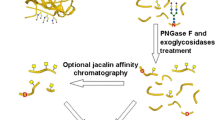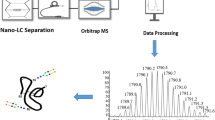Abstract
Site-specific characterization of the N- and O-linked glycosylation on a set of different human chorionic gonadotropin (hCG) drug products was performed by a LC-MS method combining high resolution (120K at m/z 200) mass spectrometry, multiple dissociation methods, tandem mass tag (TMT 10plex) labeling, and partial least squares-discriminant analysis (PLS-DA). In total, the data provided identification, relative quantification, and comparison of site-specific glycosylation of protein therapeutics with a single experiment. Ten different lots and/or brands of commercial therapeutic hCG were labeled with TMT 10plex reagents after tryptic digestion. The labeled intact glycopeptides were then analyzed by high resolution LC-MS with online alternating HCD/ETD/CID dissociation methods. For digested hCG drugs, 1000 intact N- and O-linked glycopeptides were identified. The relative amount of each glycopeptide from hCG products was determined based on the reporter signal intensities of the TMT labeling reagents. Moreover, with the help of TMT 10plex, through just one LC-MS run, PLS-DA was performed to ascertain the differences in glycosylation among different sources of hCG drug products. The results of PLS-DA showed that 167 glycopeptides were found to be significantly different between the naturally derived and recombinant hCG products. The results demonstrate the suitability of this method for similarity assessments and counterfeit identification of hCG as well as other glycoproteins.





Similar content being viewed by others
References
Woo CM, Iavarone AT, Spiciarich DR, Palaniappan KK, Bertozzi CR. Isotope-targeted glycoproteomics (IsoTaG): a mass-independent platform for intact N- and O-glycopeptide discovery and analysis. Nat Methods. 2015;12(6):561–7.
Pan S, Chen R, Aebersold R, Brentnall TA. Mass spectrometry based glycoproteomics—from a proteomics perspective. Mol Cell Proteomics. 2011;10(1):R110.003251.
Jefferis R. Glycosylation as a strategy to improve antibody-based therapeutics. Nat Rev Drug Discov. 2009;8(3):226–34.
Carter PJ. Potent antibody therapeutics by design. Nat Rev Immunol. 2006;6(5):343–57.
Jefferis R. Glycosylation of recombinant antibody therapeutics. Biotechnol Prog. 2005;21(1):11–6.
Walsh G, Jefferis R. Post-translational modifications in the context of therapeutic proteins. Nat Biotechnol. 2006;24(10):1241–52.
Sinclair AM, Elliott S. Glycoengineering: the effect of glycosylation on the properties of therapeutic proteins. J Pharm Sci. 2005;94(8):1626–35.
Zhang H, Li X-J, Martin DB, Aebersold R. Identification and quantification of N-linked glycoproteins using hydrazide chemistry, stable isotope labeling and mass spectrometry. Nat Biotechnol. 2003;21(6):660–6.
Zhu Z, Su X, Go EP, Desaire H. New glycoproteomics software, GlycoPep evaluator, generates decoy glycopeptides de novo and enables accurate false discovery rate analysis for small data sets. Anal Chem. 2014;86(18):9212–9.
Scott NE, Parker BL, Connolly AM, et al. Simultaneous glycan-peptide characterization using hydrophilic interaction chromatography and parallel fragmentation by CID, higher energy collisional dissociation, and electron transfer dissociation MS applied to the N-linked glycoproteome of Campylobacter jejuni. Mol Cell Proteomics. 2011;10(2):M000031–MCP201.
Windwarder M, Altmann F. Site-specific analysis of the O-glycosylation of bovine fetuin by electron-transfer dissociation mass spectrometry. J Proteome. 2014;108:258–68.
Ye H, Boyne MT, Buhse LF, Hill J. Direct approach for qualitative and quantitative characterization of glycoproteins using tandem mass tags and an LTQ Orbitrap XL electron transfer dissociation hybrid mass spectrometer. Anal Chem. 2013;85(3):1531–9.
Håkansson K, Cooper HJ, Emmett MR, Costello CE, Marshall AG, Nilsson CL. Electron capture dissociation and infrared multiphoton dissociation MS/MS of an N-glycosylated tryptic peptide to yield complementary sequence information. Anal Chem. 2001;73(18):4530–6.
Richards AL, Hebert AS, Ulbrich A, et al. One-hour proteome analysis in yeast. Nat Protoc. 2015;10(5):701–14.
Senko MW, Remes PM, Canterbury JD, et al. Novel parallelized quadrupole/linear ion trap/Orbitrap tribrid mass spectrometer improving proteome coverage and peptide identification rates. Anal Chem. 2013;85(24):11710–4.
Wu S-W, Pu T-H, Viner R, Khoo K-H. Novel LC-MS2 product dependent parallel data acquisition function and data analysis workflow for sequencing and identification of intact glycopeptides. Anal Chem. 2014;86(11):5478–86.
Saba J, Dutta S, Hemenway E, Viner R. Increasing the productivity of glycopeptides analysis by using higher-energy collision dissociation-accurate mass-product-dependent electron transfer dissociation. Int J Proteome. 2012;2012
Frese CK, Altelaar AM, Hennrich ML, et al. Improved peptide identification by targeted fragmentation using CID, HCD and ETD on an LTQ-Orbitrap Velos. J Proteome Res. 2011;10(5):2377–88.
Gaspari M, Verhoeckx KC, Verheij ER, van der Greef J. Integration of two-dimensional LC-MS with multivariate statistics for comparative analysis of proteomic samples. Anal Chem. 2006;78(7):2286–96.
America AH, Cordewener JH, van Geffen MH, et al. Alignment and statistical difference analysis of complex peptide data sets generated by multidimensional LC‐MS. Proteomics. 2006;6(2):641–53.
Pérez-Enciso M, Tenenhaus M. Prediction of clinical outcome with microarray data: a partial least squares discriminant analysis (PLS-DA) approach. Hum Genet. 2003;112(5–6):581–92.
Chevallier S, Bertrand D, Kohler A, Courcoux P. Application of PLS‐DA in multivariate image analysis. J Chemom. 2006;20(5):221–9.
Youssef MA, Abou‐Setta AM, Lam WS. Recombinant versus urinary human chorionic gonadotrophin for final oocyte maturation triggering in IVF and ICSI cycles. Cochrane Libr. 2011.
Chang P, Kenley S, Burns T, et al. Recombinant human chorionic gonadotropin (rhCG) in assisted reproductive technology: results of a clinical trial comparing two doses of rhCG (Ovidrel R) to urinary hCG (Profasi R) for induction of final follicular maturation in in vitro fertilization–embryo transfer. Fertil Steril. 2001;76(1):67–74.
Trinchard-Lugan I, Khan A, Porchet H, Munafo A. Pharmacokinetics and pharmacodynamics of recombinant human chorionic gonadotrophin in healthy male and female volunteers. Reprod Biomed Online. 2002;4(2):106–15.
Sakhel K, Khedr M, Schwark S, Ashraf M, Fakih MH, Abuzeid M. Comparison of urinary and recombinant human chorionic gonadotropin during ovulation induction in intrauterine insemination cycles: a prospective randomized clinical trial. Fertil Steril. 2007;87(6):1357–62.
Madani T, Yeganeh LM, Ezabadi Z, Hasani F, Chehrazi M. Comparing the efficacy of urinary and recombinant hCG on oocyte/follicle ratio to trigger ovulation in women undergoing intracytoplasmic sperm injection cycles: a randomized controlled trial. J Assist Reprod Genet. 2013;30(2):239–45.
Papanikolaou EG, Fatemi H, Camus M, et al. Higher birth rate after recombinant hCG triggering compared with urinary-derived hCG in single-blastocyst IVF antagonist cycles: a randomized controlled trial. Fertil Steril. 2010;94(7):2902–4.
Fournier T, Guibourdenche J, Evain-Brion D. Review: hCGs: different sources of production, different glycoforms and functions. Placenta. 2015;36:S60–5.
Group ERHCGS. Induction of final follicular maturation and early luteinization in women undergoing ovulation induction for assisted reproduction treatment—recombinant HCG versus urinary HCG. Hum Reprod. 2000;15(7):1446–51.
Fernández-Tejada A, Vadola PA, Danishefsky SJ. Chemical synthesis of the β-subunit of human luteinizing (hLH) and chorionic gonadotropin (hCG) glycoprotein hormones. J Am Chem Soc. 2014;136(23):8450–8.
Ye H, Hill J, Gucinski AC, Boyne II MT, Buhse LF. Direct site-specific glycoform identification and quantitative comparison of glycoprotein therapeutics: imiglucerase and velaglucerase alfa. AAPS J. 2015;17(2):405–15.
Kelly LS, Birken S, Puett D. Determination of hyperglycosylated human chorionic gonadotropin produced by malignant gestational trophoblastic neoplasias and male germ cell tumors using a lectin-based immunoassay and surface plasmon resonance. Mol Cell Endocrinol. 2007;260:33–9.
Toll H, Berger P, Hofmann A, et al. Glycosylation patterns of human chorionic gonadotropin revealed by liquid chromatography‐mass spectrometry and bioinformatics. Electrophoresis. 2006;27(13):2734–46.
Valmu L, Alfthan H, Hotakainen K, Birken S, Stenman U-H. Site-specific glycan analysis of human chorionic gonadotropin β-subunit from malignancies and pregnancy by liquid chromatography—electrospray mass spectrometry. Glycobiology. 2006;16(12):1207–18.
Author information
Authors and Affiliations
Corresponding author
Ethics declarations
Disclaimer
This publication reflects the views of the authors and should not be construed to represent FDA’s views or policies.
Rights and permissions
About this article
Cite this article
Zhu, H., Qiu, C., Ruth, A.C. et al. A LC-MS All-in-One Workflow for Site-Specific Location, Identification and Quantification of N-/O- Glycosylation in Human Chorionic Gonadotropin Drug Products. AAPS J 19, 846–855 (2017). https://doi.org/10.1208/s12248-017-0062-z
Received:
Accepted:
Published:
Issue Date:
DOI: https://doi.org/10.1208/s12248-017-0062-z




